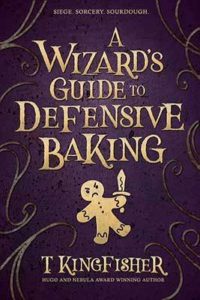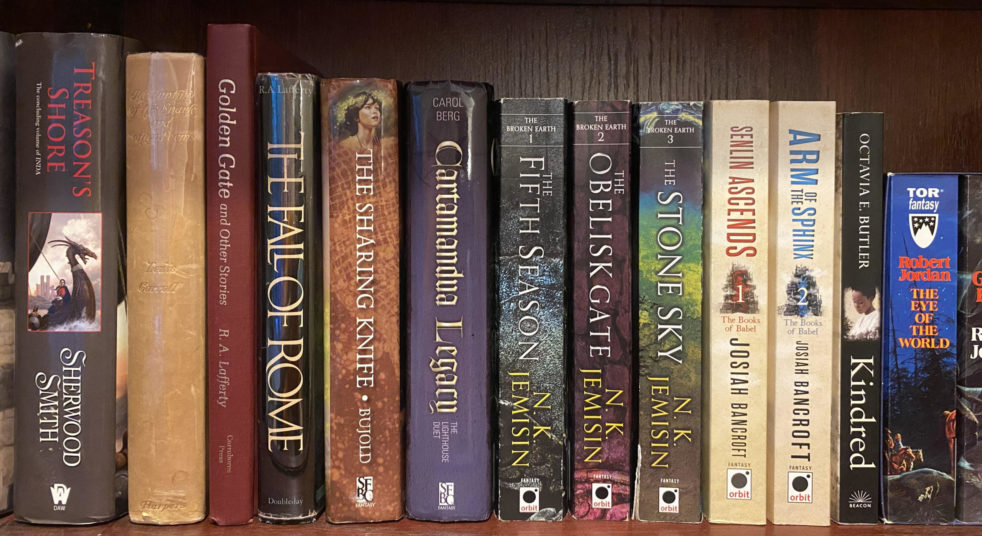
If you’re not intrigued by the title of A Wizard’s Guide to Defensive Baking, I’m not sure what to tell you. But if you think that T. Kingfisher’s pseudo-middle-grade novel can’t live up to its title, I can tell you that you’re mistaken. Whether you want humor, depth, good characters, or an interesting magic system, there’s something for you in A Wizard’s Guide to Defensive Baking.
Fourteen-year-old Mona lives a quiet life, working at her Aunt’s bakery and using her magical affinity for bread to keep the biscuits fluffy and the sourdough starter. . . active. Sometimes she even makes the gingerbread cookies dance. But when she opens the shop one morning to find a dead body on the floor, she is thrown into the midst of a powerful plot against anyone with a shred of magical talent, bread-related or otherwise. Mona has to rely on her wits and the friendship of a budding thief to save herself and her city.
This book was written for a middle-grade audience, but was self-published under a pseudonym (T. Kingfisher is also Ursula Vernon, who is known for a more lighthearted brand of children’s literature) after publishers argued it was too dark for children. The author maintains (and I agree) that children can handle more darkness than one might think, but parents and librarians have to actually buy the books, so here we are. And where we are is with an absolutely fantastic book that has something for almost all ages (I’d argue late elementary and beyond, but my kids aren’t there yet, so this isn’t speaking from experience).
Mona is an excellent central character, an older kid (but still very much a kid) with a kind heart, a bit of magic, and a lot of resourcefulness, but also with a fair helping of self-doubt and naivete. Her story moves quickly enough to keep the reader glued to the page and has enough uncertainty to keep adult readers invested, despite a few plot points telegraphed miles in advance. And for such a short novel (my Kindle copy was listed under 300 pages), we have quite a number of excellent side characters, from her gingerbread sidekick to her Aunt Tabitha–who, unlike seemingly every other adult in children’s fantasy, actually trusts Mona and aids her whenever she can–to the ten-year-old sneakthief Spindle (probably not his real name). But the thing that struck me most about the novel was the incredible conjunction of depth and humor, often in the same passages. Kingfisher can make you laugh while telling you about people taking on life-and-death responsibilities at a young age and the powers-that-be using public honors as a way to avoid reckoning with the failures that caused the situation in the first place. It’s powerful stuff, and it should not be able to be funny at the same time, but it is.
I’ve never been a reader who will pick up a book for its magic system, but the creativity behind the magic in A Wizard’s Guide is just delightful. Every wizard has an affinity for a different substance, and even ones that don’t sound too powerful can be used to great effect. To wit,
Kilsandra the Assassin grew roses. That was all she could work with. She convinced them to grow deadly poisons and sleeping powders in their pollen, and to carry messages along their stems so that she could eavesdrop on her enemies. She nailed up a few people in rose thickets with thorns as long as your arm. There are a couple kingdoms where they still won’t grow roses with a hundred yards of the palace or the army barracks, just because of her, and she died eighty years ago.
Of course, it wasn’t all roses. There was a bad decision in service of the plot, leading into one of the aforementioned telegraphed plot points. But it’s hard to be too critical knowing the target audience is a little bit less genre-savvy. And beyond that, there’s really nothing to complain about. This book is exciting, poignant, creative, and funny. It’s the whole package, for adults and middle-grade readers alike.
Recommended if you like: kids saving the day, creative magic, humor and poignancy.
Overall rating: 18 of Tar Vol’s 20. Five stars on Goodreads.
